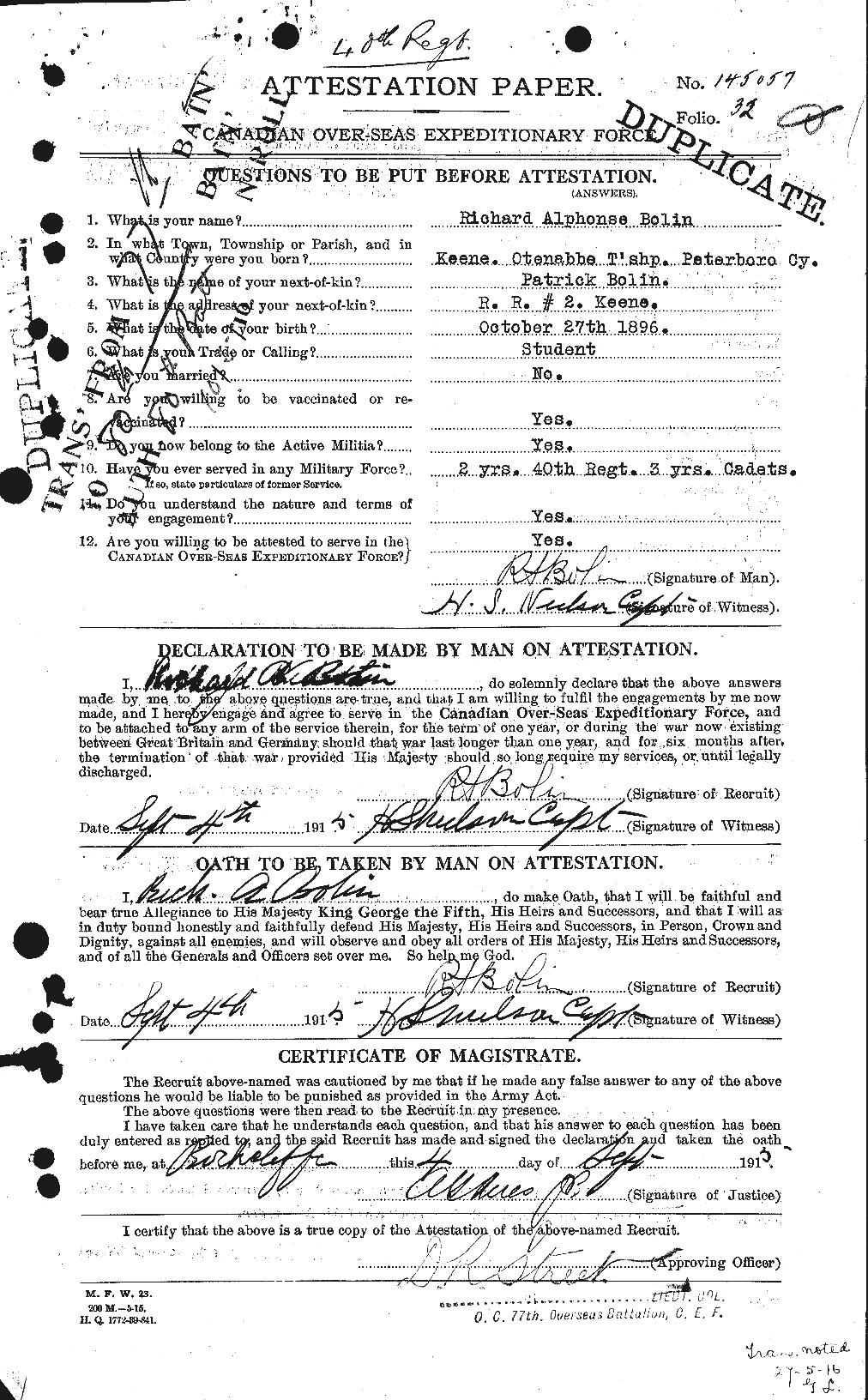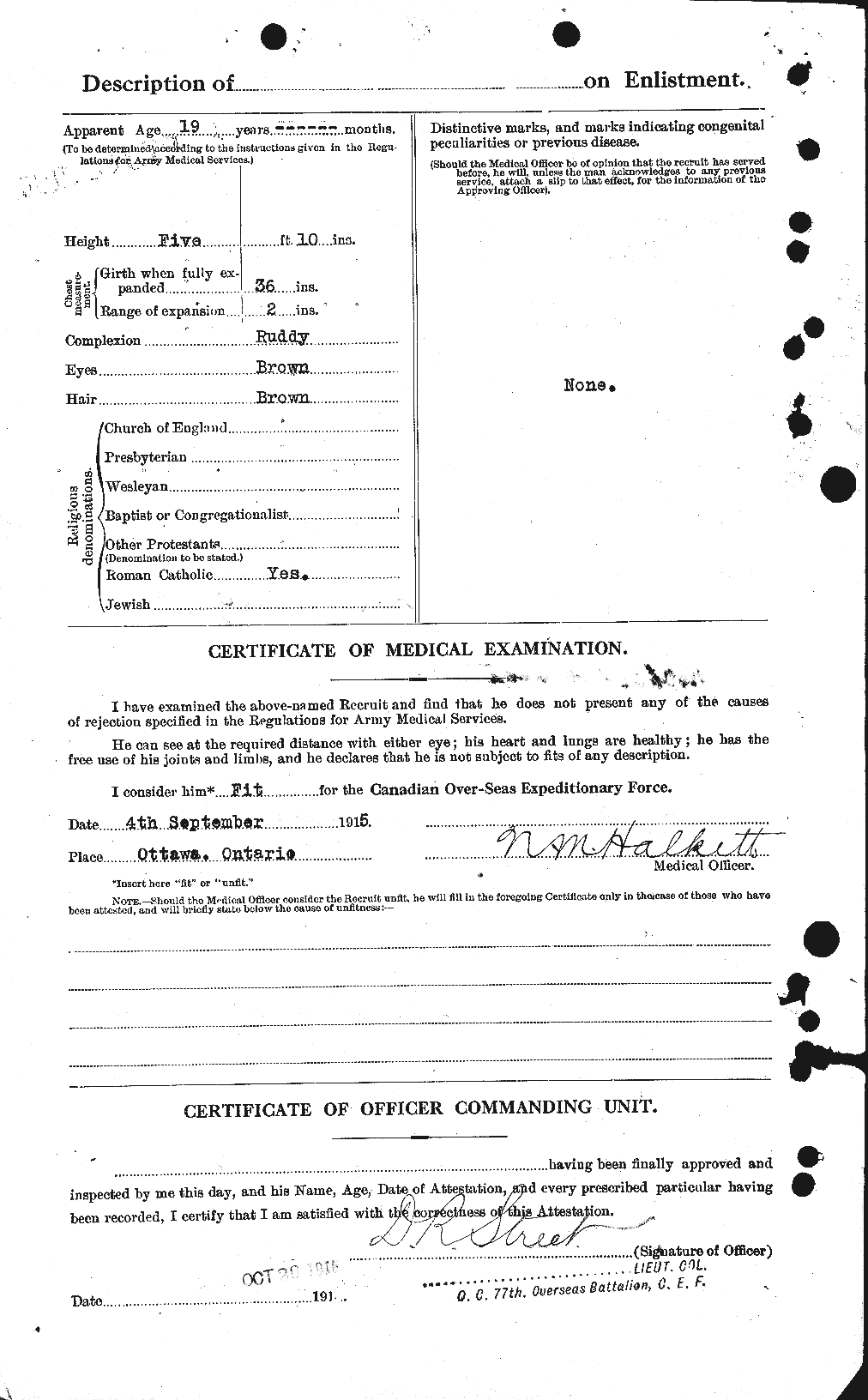


Courtesy of Anna Marie Bolin


Courtesy of Anna Marie Bolin

Bolin plot of land
Courtesy of the Otonabee South-Monaghan Historical Society

Peterborough Book of Remembrance
Richard Alphonse Bolin
1896-1916
Richard Alphonse Bolin was born on October 27th, 1896, in Keene, Ontario, to parents Patrick Bolin and Catherine Gilroy. He was one of seven children, along with John Louis, known as Lou, (1881-1935), Bridget Anne (1883-1955), Michael Augustine, also known as Gus (1885-1961), Patrick Gilroy (1890-1961), Francis Emmett (1891-1946), and Mary Margaret (1898-1986). He was born on the family’s farm (Shanty Shore Farm), lot 9, concession 6, R. R #2. Richard (often called Phonse) had a ruddy complexion, brown hair and brown eyes. He was 5ft. 10in., and was 138 pounds. Phonse did not have any marks or scars to define him written on his medical exam. His mother, Catherine, passed away in 1905. Therefore, his eldest sister, Annie, took care of him when he was eleven years old, along with his nine-year-old sister, Mary Margaret. All of the children went by their middle names.
Since he lived on a farm, and his father was a farmer, Richard Alphonse probably had chores to do. He would have likely had to bring in the hay, feed the chickens, and tend to the cows and horses. But his family and friends also spent time catching sucker fish at Burnham’s Dam. As a boy, he attended S.S. No. 4 school in Keene. When he enlisted in the First World War, he wrote that he was a student as his calling. Richard attended a high school in Norwood, and later taught at the Glen Alda school. He received a letter from the students he taught at Glen Alda, wishing him luck before the war. His goal was to take the engineer course at the Royal Military College in Kingston, ON. His family attended the St. John the Evangelist Roman Catholic church, and his brothers bought his sister, Bridget Anne (Annie), the house across from the church, later on. Some members of the Bolin family are buried in the St. Peter’s cemetery in Peterborough, Ontario.
At his high school in Norwood, he was captain of the cadets. He had spent three years in Cadets, and two years in the 40th regiment. Richard Alphonse Bolin signed up for the First World War, and was considered fit for the Canadian Over-Seas Expeditionary Force on September 4th, 1915, in Rockcliffe, Ottawa. He decided that his next-of-kin was his father, Patrick Bolin (185-1933). His brothers Patrick Gilroy (Roy), and Francis Emmett also enlisted in the war. Phonse enlisted in the 77th Overseas Battalion, CEF, and was promoted to Lance Corporal on September 9th, 1915. He was transferred to the 80th Battalion on October 8th, 1915. This means that he did not fight with the 77th Battalion. His regimental number was 145057. When he went overseas with the 80th Battalion, he was a signaller.
Signallers were often near the front line, communicating with the Company and with the battalion. In the beginning of the war, it was common for signallers to use flags to send signals. However, other technologies were later developed, like using sunlight and mirrors in the daytime, and lamplight at night. Other ways to communicate included morse code, trench signalling lamps, and heliographs. One man would send the signals, and the other would read the ones at great distances with a telescope. Of course, wired telephones were sometimes used, but only if it was safe to lay the landlines. Signallers were almost always in danger because of their proximity to the front line, with risks of enemy shelling and attacks.
On March 1st, 1916, Phonse was a witness of his brother Gus’ marriage to Helena (Lena) Lynch. He got on a train on the Canadian Pacific Railway, in Belleville, Ontario, on Saturday, May 13th, to go to Halifax, Nova Scotia. He passed through Montréal, Quebec, where he changed to the Intercolonial Railway, and also went through Moncton, and a lot of other cities. He arrived in Halifax on Monday. From Halifax, he took the S.S. Baltic, and arrived in England on May 30th. On May 28th, 1916, while still on the boat, he wrote a letter to his sister Anna, describing his trip so far. They landed in Liverpool on a Monday; however, the date is not stated in the letter. He continued his letter in Bordon, Hampshire on May 31st, 1916.
On June 13th, 1916, Richard was transferred from the 80th Battalion to the 74th Battalion. He was a Corporal in the 74th Battalion, and on July 17th, 1916, he wrote a military will. This will stated that all of his property would go to his sister Anna Bolin (Bridget Anne), if he were to die. She lived at R. R #2, in Keene, either still living on the family farm, or in her new house across from the church. The next day, on July 18th, 1916, he transferred from the 74th Battalion to the 102nd Battalion, a British Columbian battalion. He left for France around August 11th, and was promoted to Corporal in the field on August 17th. He was already a Corporal in the 74th Battalion, and soldiers would not lose their ranks when they were transferred. He probably lost his position somehow, but this is not proven. As a Corporal he made $15.00 a month.
Richard Alphonse Bolin, as a part of the 102nd Battalion, fought in the Battle of Somme. Before he left for the Somme, he spent time in September and early October open-air training for the battle ahead. According to war diaries from the 102nd Battalion, the training was difficult in the hot weather and on dusty roads. A lot of the following information is from the 102nd Battalion's War Diaries. On October 3rd, the battalion left for Somme. Each soldier traded their Ross rifle for a Lee Enfield and a box respirator. They went to Audruicq, and then took a train to the town of Doullens. From Doullens they went straight to Gézaincourt to stay. The battalion then travelled through Val de Maison to arrive at Vadencourt where the Canadian Corps Headquarters was located. On October 10th, they left for Albert, which they were to use as base headquarters. Soon after, the 102nd Canadian Infantry Battalion went to Tara Hill and used it as headquarters.
On October the 18th, the 102nd Battalion “took over from the 87th Bn, the front line trenches on the left sector of the Brigade...this being a front of 500 yards extending from Courcelette Trench on the left flank to Ross Communication Trench on the right”. That evening, the 78th Battalion was attacked, and the 102nd was needed to “come up on the double”. There was heavy shelling, and a lot of mud. “Day broke with rain pouring down in torrents, making the ground absolutely impassable and the Higher Command decided to postpone operations until the 21st inst. "B", "C", and "D" Coys. therefore returned to camp at Tara Hill, leaving "A" Co. to hold the line.” “...on the evening of the 20th the three companies were again brought into the front line, relieving "A" Co. which went into Support.” The men worked all night to dig the trenches (October 20th). The next day, the 21st, at 12:06pm, the 102nd Battalion went ‘over the top’. They ran into Regina Trench and surprised the Germans; they took the trench, and many prisoners along with them. However, an hour and a half later the Germans counter-attacked three times, and the Battalion “successfully opposed them”. The rest of the day and night there was heavy shell fire. Twenty-eight people were killed and seventy were wounded from the 102nd Battalion.
This was the day, October 21st, 1916, that Cpl. Richard Alphonse Bolin was killed in action. He died in the Battle of Somme, France. He has no known grave; however, his name is mentioned on many memorial plaques. His name, ‘Alphonse Bolin’, is written on the World War One and Two memorial in the village of Keene. His name is also on the Vimy Memorial in Pas de Calais, France. Richard Alphonse Bolin died six days before his twentieth birthday. His brother, John Louis, received a message of his death, and his obituary ended up in the Toronto Star, November 4th, 1916. Patrick, his father, was sent a telegram from Ottawa on November 3rd, 1916, also stating his death. Phonse’s other brother, Roy, often wrote poetry. He wrote a poem (below) about Richard Alphonse’s death, which stayed in the family. His name was also mentioned in the Belleville Intelligencer on November 6th, stating that his father, Patrick Bolin, got a message of the death of his son. Richard Alphonse Bolin’s name is written on the family’s grave in St. Peter’s cemetery, in Peterborough, Ontario, Canada, where other members of his family are buried.




Authentic letters written by Phonse; courtesy of Anna Marie Bolin

This page is displayed in the Memorial Chamber of the Peace Tower in Ottawa on February 14

An example of a signalling post

White Star Line's S.S. Baltic - the ship Phonse took to England

Telegram sent to Phonse's father, Patrick; courtesy of Anna Marie Bolin

In Memory of Phonse
Where the rippling Somme is flowing
Through the blood stained soul of France
Lies a grave with naught to cheer it
Save the silvery moonbeams dance
Within it lie the ashes
Of a brother held so dear
Whose spirit young and noble
Has fled this earthly sphere
He was born to be a soldier
And his country’s call was heard
Though loving ties were hard to break
He buckled on the sword
With a soul that knew no danger
And a heart that knew no fear
On the field of honour gave his life
For a cause we hold so dear
There are thousands gone before him
There are thousands yet to come
Who ne’er will let the sword be sheathed
Till France and Belgium are won.
Though he left this earth forever
Yet his memory’s still a light
As when together down life’s path
We trod with hearts so bright.
And we know that we shall find him
At the last great bugle call
In the ranks of those who served the best
The God who’s over all.
Patrick Gilroy (Roy) Bolin (1890 - 1961) wrote this poem in memory of his brother Richard Alphonse (Phonse) Bolin who was killed on October 1916. Phonse was born October 27, 1896 in Keene, the second youngest of 7 children born to Patrick Bolin and Catherine Gilroy. He taught school for a short time before enlisting in 1915. Roy subsequently enlisted in January 1918.
Courtesy of Anna Marie Bolin


Authentic attestation papers from World War One

S.S. No. 4, Keene Public School; Alphonse is in the second row from the back; third child from the left; in a dark jacket, 1904
Courtesy of the Otonabee South-Monaghan Historical Society

Bolin family photograph (Phonse is around two years old on his father's lap);
courtesy of the Otonabee South-Monaghan Historical Society
Thank you to Anna Marie Bolin, Kathryn Campbell, and the Otonabee South-Monaghan Historical Society for many images found on this site and in the video. Photos of the memorials/gravestones and the church were taken by Alexis Thompson. The war art was created by Harvey Anthony, J. P. Beadle, and Jason Askew respectively.